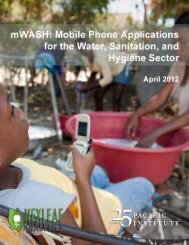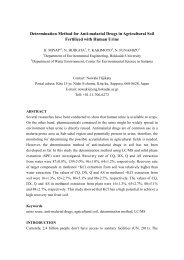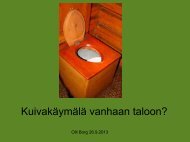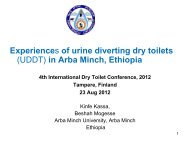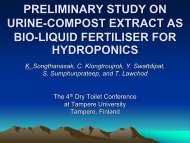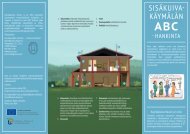Evaluation of social and cultural acceptance of the biotoilet system
Evaluation of social and cultural acceptance of the biotoilet system
Evaluation of social and cultural acceptance of the biotoilet system
Create successful ePaper yourself
Turn your PDF publications into a flip-book with our unique Google optimized e-Paper software.
concepts introduced in that model. The treatment <strong>of</strong> blackwater conceived a change in <strong>the</strong><br />
traditional way <strong>of</strong> using <strong>the</strong> toilet; <strong>the</strong> use <strong>of</strong> water in <strong>the</strong> toilet was thought just to clean <strong>the</strong> toilet,<br />
not to transport <strong>the</strong> toilet wastes; this was a very important change that it was possible by using <strong>the</strong><br />
<strong>biotoilet</strong>. Several benefits are derived from <strong>the</strong> implementation <strong>of</strong> <strong>the</strong> OWDTS, which can be found<br />
in Lopez Zavala et al. (2002).<br />
After <strong>the</strong> introduction <strong>of</strong> <strong>the</strong> OWDTS concept, intensive research was conducted to support<br />
scientifically <strong>the</strong> <strong>system</strong>. This goal was achieved successfully during <strong>the</strong> subsequent years, but <strong>the</strong><br />
implementation in practice <strong>of</strong> <strong>the</strong> <strong>system</strong> was an aim moving forward.<br />
Development <strong>of</strong> holistic sustainable <strong>system</strong>s based on <strong>the</strong> OWDTS concept has been achieved on<br />
<strong>the</strong> practice through <strong>the</strong> implementation <strong>of</strong> two pilot <strong>system</strong>s in both rural <strong>and</strong> urban areas <strong>of</strong><br />
Central Mexico, State <strong>of</strong> Guanajuato (Fig. 1). Such pilot <strong>system</strong>s involved <strong>the</strong> design <strong>and</strong><br />
installation <strong>of</strong> rainwater <strong>system</strong>s, installation <strong>of</strong> <strong>biotoilet</strong>s, <strong>and</strong> <strong>the</strong> design <strong>and</strong> construction <strong>of</strong><br />
controlled soil natural treatment <strong>system</strong>s (Fig. 2). Social <strong>and</strong> <strong>cultural</strong> <strong>acceptance</strong> <strong>of</strong> <strong>the</strong> <strong>biotoilet</strong><br />
<strong>system</strong> was a crucial <strong>and</strong> sensitive factor for <strong>the</strong> successful implementation <strong>of</strong> <strong>the</strong> OWDTS.<br />
Unfortunately, on literature <strong>the</strong>re was not available a <strong>system</strong>atic methodology to assess <strong>the</strong> <strong>social</strong><br />
<strong>and</strong> <strong>cultural</strong> <strong>acceptance</strong> <strong>of</strong> <strong>the</strong> <strong>biotoilet</strong> o similar <strong>system</strong>. The German International Cooperation<br />
Agency (GTZ) has presented reports in different congresses where <strong>the</strong> socio<strong>cultural</strong> <strong>acceptance</strong> <strong>of</strong><br />
ecosan technologies has been evaluated; however, details <strong>of</strong> <strong>the</strong> methodology implemented are not<br />
deeply described (Werner et al., 2003). In Mexico, <strong>the</strong>re are not reports where similar evaluation<br />
has been conducted during introduction <strong>of</strong> new technologies. Thus, in this study, a simple<br />
methodology was implemented to assess <strong>the</strong> socio<strong>cultural</strong> <strong>acceptance</strong> <strong>of</strong> <strong>the</strong> <strong>biotoilet</strong> <strong>system</strong>.<br />
Methods<br />
The first questions that arose during this study were “what kind <strong>of</strong> technology will be compared<br />
with <strong>the</strong> <strong>biotoilet</strong> <strong>and</strong> how <strong>the</strong> <strong>acceptance</strong> will be assessed”. Trying to answer <strong>the</strong>se questions <strong>the</strong><br />
procedure adopted was as follows:<br />
1. Selection <strong>of</strong> sanitation technologies against <strong>the</strong> <strong>biotoilet</strong> <strong>acceptance</strong> was compared.<br />
Based on <strong>of</strong>ficial governmental reports at municipal, state <strong>and</strong> federal level, <strong>the</strong> most<br />
common technologies promoted <strong>and</strong> used for onsite sanitation in <strong>the</strong> state <strong>of</strong> Guanajuato,<br />
Mexico were identified. These technologies were selected to assess <strong>the</strong>ir <strong>acceptance</strong> in<br />
comparison with that <strong>of</strong> <strong>the</strong> <strong>biotoilet</strong>.<br />
2. Preparation <strong>of</strong> a reliable survey format to assess <strong>the</strong> socio<strong>cultural</strong> <strong>acceptance</strong> <strong>of</strong> <strong>the</strong><br />
<strong>biotoilet</strong>. This step consisted in:<br />
a. Preparation <strong>of</strong> <strong>the</strong> survey format, contents <strong>and</strong> interviews to users.




